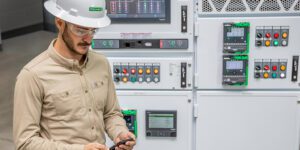Table of Contents
- The rising demand for solar
- Developments in the electrical industry landscape
- The pros and cons of adding solar to your service portfolio
- Premium service offerings like solar can differentiate your business
- Use solar to recruit and upskill your workforce
- Become a clean energy service provider and create customers for life
- How to get started in solar: The technology to make your job easier
If you’ve considered adding solar power and storage capabilities to your electrical installation services, now might be the right time. According to solar adopters like Tyler Keezer, president of Switch Electric Home Energy, solar is the smart energy move for electrical professionals who want to grow their customer base and create customer loyalty.In this article, we’ll share additional insights from electrical contractors like Keezer who have expanded their electrical services to include solar installation. We’ll dive into some of the pros and cons of adding solar to your electrical installation services and explore key trends driving today’s new, smart energy landscape.
The rising demand for solar
Current and prospective homeowners are now more energy conscious than ever before. “They want more energy resiliency because they’re hearing about blackouts and brownouts. To them, resilience means they don’t have to worry about blackouts if they want to charge their new electric vehicle,” Keezer says.
He notes that homeowners are also motivated by new tax credits, including recent changes to the Inflation Reduction Act (IRA), which allows homeowners to take up to 30% of the cost of installing a new solar system, storage, and more in tax credits and rebates.
Keezer’s home electrical retrofit services are in high demand as homeowners are looking to solar to offset rising electricity costs and ensure reliable energy supply. “Solar can be very profitable once you’ve learned how to do it,” he says. “It’s also very appealing from an electricity standpoint if you want to be part of the new ‘cool technology’ that is impacting our customers’ lives.”
Keezer is not the only electrical contractor who has expanded his business by offering more premium electrical services like solar power and backup capabilities. In addition to solar installation services, electrical installers are also increasingly adding electric vehicle (EV) charging installs, smart panel installs, home automation commissioning, and other premium home electrification services to position themselves as leaders in their respective markets.
Developments in the electrical industry landscape
Homeowners experienced some of the biggest spikes in electricity costs in 2022 and 2023, according to the U.S. Energy Information Administration. This is because wholesale electricity markets are strongly influenced by natural gas prices, which also have been on the rise, according to the Department of Energy in the U.S. Chamber of Commerce.
Given these challenges, it’s no surprise that solar has experienced an average annual growth rate of 22% in the last decade, per recent reports from the Solar Industries Association (SEIA). According to the report, there are now more than 179 gigawatts (GW) of solar capacity installed nationwide, enough to power nearly 33 million homes.
There’s also a growing demand for more sustainable energy solutions from potential electrical customers. According to surveys conducted by the Pew Research Center, 69% of Americans support the U.S. taking steps to become carbon neutral by 2050. This may especially be the case for millennials and Gen Z, who are willing to pay more for sustainable products, according to a recent survey from Green Builder Media. Millennials now make up the largest pool of home buyers, according to the 2024 Home Buyers and Sellers Generational Trends Report by the National Association of Realtors®, with the youngest millennials (aged 25 to 33 years) now buying homes for the first time.
The pros and cons of adding solar to your service portfolio
The tax credits under the IRA provide a big incentive for homeowners to add solar power and battery storage capabilities to their homes. As a big picture for electrical contractors: the IRA could deliver as much as $14,000 in rebates and tax credits to many U.S. households, according to the Edison Electric Institute. This includes the Residential Clean Energy Credit for clean energy upgrades such as installing rooftop solar panels and battery storage, along with the Home Energy Rebate programs that can include new electrical panels and wiring.
The high demand in solar also benefits contractors and electricians by:
- Increasing competitiveness in an increasingly disruptive energy market.
- Developing more lines of revenue by expanding and strengthening customer
- relationships to go beyond traditional home energy offerings.
“Solar has more potential for greater profit margins,” Keezer says. “And you can pass those margins onto the guys on your team who do the work.”
Yet even with all the reasons for going solar, it may not be for everyone, according to Keezer. “We have 25 people here and about six of those 25 enjoy doing solar,” he says. “The rest of them will do it, but they don’t love it. It takes a certain someone to want to be up on that roof all day and setting panels and all that kind of stuff.”
Keezer says there is a big learning curve when it comes to installing solar panels and storage systems, including overcoming challenges such as:
- Safety issues: Steep roof pitches can change the entire scope of installing solar panels when you have to add safety equipment like harnesses to do the job.
- Racking considerations: You have to take wind speeds and other weather conditions into consideration. Plus, some homes lack trusses, making it difficult to distribute the weight of panels on a roof.
- Permit sets: Understanding how to read permit sets is essential to answering solar installation questions such as:
- How do you string up solar panels?
- Should you use DC or AC strings?
- How do you properly set a panel for aesthetics, to meet customer expectations both inside and outside of the home?
For example, when Matt Trout, president of Trout Electric, wanted to add EV charging installation to his company’s growing portfolio of electrical services, he quickly realized that he would have to change his hiring strategies. The problem was, when he ran a job ad for a “residential services technician” he only received six responses.
In response, Trout created a new job ad: “Electrification: Join the new journey: Electric vehicle charging, battery installs, solar integration.” Within 24 hours, he received 84 new job applications.
Despite these challenges, more electrical contractors like Keezer are adding solar to their portfolio of installation services because the potential business makes it worth the effort. Committing to providing clean energy options can reap big financial rewards, he notes.
Premium service offerings like solar can differentiate your business
Use solar to recruit and upskill your workforce
Your team’s skills are crucial factors that drive customers to choose your business over the competition. Offering premium electrical services indicates a higher level of skills to your customers and to potential talent who are eager to work in more high-tech fields.
“Out of those 84, about 70 of them were with other companies and currently working,” Trout says. “So we were attracting top talent from companies in the area. Everybody wants to further their careers and be at the top of the new wave of construction.”
He plans to add more premium electrical services in the future to help him upskill his workforce. Trout shared these insights as part of a panel of electrical contractors hosted by Schneider Electric™, From One Contractor to Another: “How I’m Expanding My Business in the New Energy Landscape”.
Become a clean energy service provider and create customers for life
If you can demonstrate that your business is the one-stop shop for evolving electrical needs, you can establish long-lasting customer relationships. This is especially true for clean energy services such as solar installation. By providing the option to add solar capabilities today and in the future, you are creating a better customer experience. With this approach, your business can become the go-to spot for those wanting to future-proof their homes — which in turn helps future-proof your business.
Keezer says he made the jump to solar because he believes clean energy is the future for electrical professionals.
“I believed in clean energy, so I wanted to learn more about it,” he says. “I tried to find as much information and training opportunities as I could. There are suppliers who can help with training, such as setting up mock roofs for solar panel installations and racking demonstrations.”
But at the end of the day, Trout says the ability to offer more clean energy options is key to creating better customer experiences.
“I tell my crew that if you walk out of a job and that customer doesn’t tell you, ‘You’re my electrician for life,’ then you’ve failed,” he says. “This is just the starting point in this journey for electrification, to really grow the business and separate yourself from that ‘lug’ man mentality to being a solutions provider.”
From QO Plug-on Neutral (PoN) load centers to a fully integrated energy management system, Schneider Electric technology is scalable enough to help you future-proof your customers’ homes. With this foundation, they can add renewable electrical options in the future.
For example Schneider Home allows customers to easily combine grid power, solar, battery, and EV charging into a single connected system. It includes the Schneider Pulse smart panel, designed to make it easy for your customers to automate energy use and monitor electrical consumption. It also connects easily to the Schneider Boost home battery and Inverter, for simple installation and faster paybacks for customers.
Read our new e-guide to learn more. The e-guide also provides hands-on guidance to help you get started with solar, including how to prepare your customers’ homes for the new energy landscape.
How to get started in solar: The technology to make your job easier
If you’re getting serious about solar, Schneider Electric can help simplify your installation projects for each step of your customers’ electrification journey — including solar, storage, and smart load management.




Add a comment